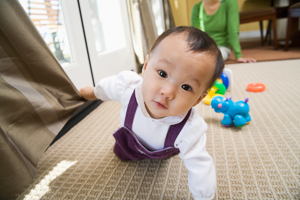Cataracts in Children
Condition Basics

What are cataracts?
Cataracts are a painless, cloudy area in the lens of the eye. They block the passage of light to the retina. Nerve cells in the retina detect light entering the eye and send nerve signals to the brain about what the eye sees. Because cataracts block this light, they can cause vision problems.
What causes them in a child?
Cataracts are rare in babies and children. But children may be born with cataracts or develop them as a baby, child, or adolescent. Some things that may cause cataracts in a child include genetics, infection during pregnancy, low birth weight, an eye injury, and some medicines.
What are the signs of cataracts in a child?
Here are some signs of cataracts in children:
- You may see a cloudiness in your child's eye.
- Your child may not look directly at or respond to faces or large, colorful objects. A baby who can't find small objects when crawling on the floor may have cataracts.
- Your child may scowl, squint, or shield their eyes more than expected when in bright sunlight.
- Your child's eyes may be misaligned and not focus on the same point at the same time.
- You may see a white reflex instead of a red reflex in your child's eye. For example, in a photo of the child, one eye may appear white while the other has the normal "red eye" look.
- The affected eyes may have repetitive wandering movements. This is usually a later sign of cataracts.
How are cataracts in children diagnosed?
Most of the time, cataracts are found at birth during a doctor exam before the baby leaves the hospital or during well-child checks. If a doctor finds signs of a cataract during an eye exam, your child will be referred to a specialist for diagnosis and treatment.
How are they treated?
Children who have vision problems from cataracts usually need surgery to remove the cataract. This is done to help prevent lasting vision loss and to be sure that the child develops the best vision possible. After surgery, the child may need to wear a patch on one of their eyes, wear contact lenses or glasses, or use eyedrops. They may need to do one of these things or some combination of them.
Early treatment is best. Having cataract surgery in the first few months of life can lower a child's risk of having other vision problems.
Credits
Current as of: June 5, 2023
Author: Healthwise Staff
Clinical Review Board
All Healthwise education is reviewed by a team that includes physicians, nurses, advanced practitioners, registered dieticians, and other healthcare professionals.
Current as of: June 5, 2023
Author: Healthwise Staff
Clinical Review Board
All Healthwise education is reviewed by a team that includes physicians, nurses, advanced practitioners, registered dieticians, and other healthcare professionals.
This information does not replace the advice of a doctor. Healthwise, Incorporated, disclaims any warranty or liability for your use of this information. Your use of this information means that you agree to the Terms of Use. Learn how we develop our content.

